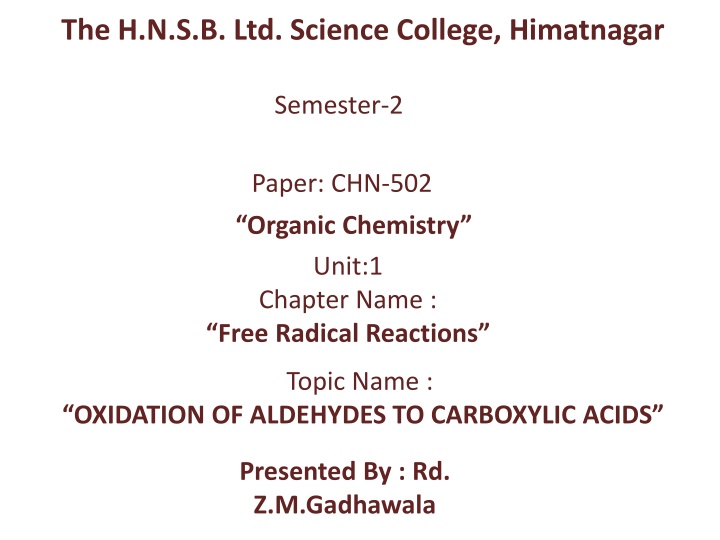
Oxidation of Aldehydes to Carboxylic Acids in Organic Chemistry
Explore the oxidation of aldehydes to carboxylic acids in organic chemistry using various oxidizing agents such as permanganate, chromic acid, and more. Learn about the mechanisms involved, including free radical and ionic processes, and how atmospheric oxygen can also be used for oxidation. Dive into the intricate details of this important chemical transformation.
Download Presentation

Please find below an Image/Link to download the presentation.
The content on the website is provided AS IS for your information and personal use only. It may not be sold, licensed, or shared on other websites without obtaining consent from the author. If you encounter any issues during the download, it is possible that the publisher has removed the file from their server.
You are allowed to download the files provided on this website for personal or commercial use, subject to the condition that they are used lawfully. All files are the property of their respective owners.
The content on the website is provided AS IS for your information and personal use only. It may not be sold, licensed, or shared on other websites without obtaining consent from the author.
E N D
Presentation Transcript
The H.N.S.B. Ltd. Science College, Himatnagar Semester-2 Paper: CHN-502 Organic Chemistry Unit:1 Chapter Name : Free Radical Reactions Topic Name : OXIDATION OF ALDEHYDES TO CARBOXYLIC ACIDS Presented By : Rd. Z.M.Gadhawala
OXIDATION OF ALDEHYDES TO CARBOXYLIC ACIDS Oxidation of aldehydes to carboxyclic acids has been carried out with many oxidising agents, the most popular of which is acidic, basic, or neutral solution of permanganate, chromic acid, silver oxide, bromine, Benedict s solution and Fehling s solution. The mechanism of aldehyde oxidation may be free radical or ionic. Both the mechanisms may take place together. In the free radical mechanism, the aldehydic hydrogen is abstracted to give an acyl radical, which obtains OH from the oxidising agent, for example: . R C O R C O +H 2CrO 4 +Cr(V) H O . +Cr(V) +H 2CrO 4 R C O R C OH
The mechanism is similar with KmnO4 also. For alkaline permanganate, the ionic mechanism is as follows: - O O - - OH MnO4 slow RCOOH + HMnO42- R C H R C H OH - - RCOO + MnO3 + H2O
For neutral and acidic permanganate, the following ionic mechanism has been proposed: MnO3 O O O - B HMnO4 Mn(VII) + + R C H R C BH R C H OH OH - MnO3 Mn(V)+ Similarly, with H2CrO4, the ionic mechanism is follows: O O CrO3H O H2CrO4 Cr(VI) + + R C H R C H R C BH - B OH OH + - HCrO3 Cr(IV)
Aldehydes are also oxidised to carboxylic acids by atmospheric oxygen. The direct oxidation product in this case is the per oxyacid RCO3H, which disproportionates with another molecule of aldehyde to give two molecules of acid. O O O . . . O2 + R H + R C H R O R C R C O O O . R C R C H O RCHO 2RCOOH O H R C O
